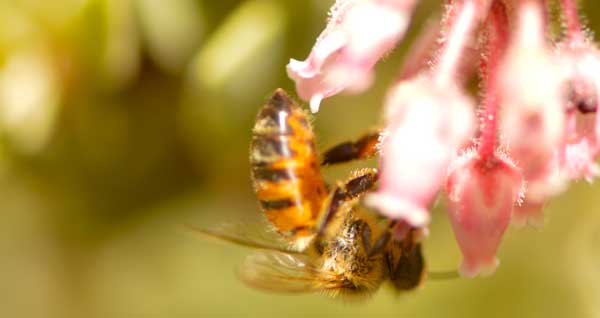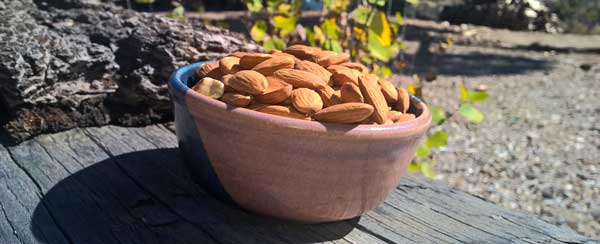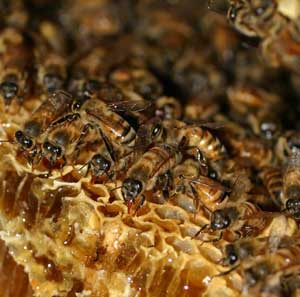![]() Really Cool Thing about the Spring Season: new plants pop up left and right, and beautiful flowers are in bloom.
Really Cool Thing about the Spring Season: new plants pop up left and right, and beautiful flowers are in bloom.

 Safety Consideration of the Spring Season: it’s the time of year when we must warn our students to be careful when examining plants, such as the manzanita bush, because their flowers are bee magnets.
Safety Consideration of the Spring Season: it’s the time of year when we must warn our students to be careful when examining plants, such as the manzanita bush, because their flowers are bee magnets.
This buzzing sound provides a great opportunity to talk about how bees are doing these days.
 According to bee scholar Marla Spivak, honey bees have been decreasing in the United States since World War II and we now have half the amount of commercially managed hives as we did in 1945. Marla’s TED Talk, “Why Bees are Disappearing,” did a nice job of clearly explaining a bee’s role (specifically honey bees), what we’re doing wrong, and most importantly, how we can do right.
According to bee scholar Marla Spivak, honey bees have been decreasing in the United States since World War II and we now have half the amount of commercially managed hives as we did in 1945. Marla’s TED Talk, “Why Bees are Disappearing,” did a nice job of clearly explaining a bee’s role (specifically honey bees), what we’re doing wrong, and most importantly, how we can do right.
A Bee’s Role
First and foremost, bees are one of the most important pollinators of fruits, vegetables, flowers, and crops that feed our farm animals, such as alfalfa hay. More than 1/3 of the world’s crop production is dependent on bee pollination. Amazingly, there are over 20,000 species of bees.
Humans have been drawn to honey bees since early recorded history, mostly to harvest their honey. However, honey bees are not the only important pollinators worth mentioning.
For example, bumble bees are crucial, too. Tomatoes benefit greatly from bumble bees because they vibrate the tomato flower which releases the pollen hidden deep inside the male part of the flower called the anther. Since bees have been declining, tomato growers have begun pollinating the flowers with a handheld vibrator called the “tomato tickler.” Now that’s a crazy sounding concept if I’ve ever heard one, and not to mention, natural pollination done by bumble bees often makes better quality tomatoes. We can’t always replace nature.
 What happened after World War II that changed the world of honey bees?
What happened after World War II that changed the world of honey bees?
First, we stopped planting cover crops such as clover and alfalfa that are highly nutritious for bees and also great natural fertilizers that fix nitrogen in the soil. We turned to synthetic fertilizers instead. Additionally, we started using herbicides to kill weeds. Many of these “weeds” are actually flowering plants that bees count on for nutrition.
Next, the movement of monoculture farms began. Monoculture farms grow only one or two plant species such as corn or soy beans in the United States. This creates a food desert for bees. Imagine places in the United States that lack grocery stores and food options. This is what’s happening to bees. Farms that used to be diversified and provided an assortment of food options are now ruled by one or two crops that usually do not provide balanced nutrition for bees.
 One relevant example of monoculture in California is almond farms. Almonds are actually beneficial to bees – the pollen in an almond blossom is very high in protein. However, the large amount of almond monoculture farms now require that the majority of our nation’s managed honey bee hives, about 1.5 million bees, must be transported across the nation to pollinate just this one crop.
One relevant example of monoculture in California is almond farms. Almonds are actually beneficial to bees – the pollen in an almond blossom is very high in protein. However, the large amount of almond monoculture farms now require that the majority of our nation’s managed honey bee hives, about 1.5 million bees, must be transported across the nation to pollinate just this one crop.
The bees are brought in semi-truck loads and then are transported back out because after the almonds bloom, the almond orchards are a flowerless desert and the bees would not have enough food to survive. Does that sound like a functional system?
“Monocultures, the agricultural practice of producing or growing genetically similar, or essentially identical plants, over a large areas (stands), year after year, is widely used in modern industrial agriculture. It is often argued that monoculture produces greater yields by utilizing plants’ abilities to maximize growth under less pressure from other species and more uniform plant structure. What is not appreciated is that modern crops and livestock vitally depend on hundreds of thousands of other species, including insects and birds that pollinate crops and feed on pests, and numerous microbial species that live on and in plants and animals, and that are especially critical to survival.” See more here.
The rise of pesticides is another attributing factor to bee decline since World War II. The monoculture farms often grow crops that attract many “pesty” bugs which is why an assortment of harmful pesticides came into play. According to research conducted by Penn State University, each batch of pollen that a honey bee brought back to its hive had at least six types of pesticides in it. Aren’t these the same crops that we’re eating throughout the country? Shouldn’t this be a mirror for the food that we’re ingesting on a daily basis? Perhaps bees are trying to tell us something.
Aside from human interference, honey bees also have their own problems to worry about such as parasites and viruses that can kill them. With so many opposing forces, how can we expect them to thrive in a landscape of such obstacles? The bottom line is we can’t afford to lose bees. It’s clear bees are dying for multiple, interacting reasons, and this reflects a flowerless landscape and a dysfunctional food system.
Luckily, there is hope for Bees.
We can help bees in several doable ways.
1: One way is to plant native, bee-friendly flowers and be sure to not contaminate these flowers with pesticides. What we lack is a diversity of flowers that will bloom over the entire growing season from spring to fall. Not only will these flowers help bees, but will also benefit migrating butterflies, birds, and other wildlife.
2: Next, we need to integrate cover crops back into our farms to feed bees and keep the soil healthy.
3: Finally, there needs to be a movement to re-diversify farms and, at the least, plant neighboring flowers along monoculture crops.
 The big picture is if bees have access to good nutrition, WE also have access to good nutrition. Keep the bees alive and educate those around you! Do your part to keep our world balanced and healthy. We’re all connected.
The big picture is if bees have access to good nutrition, WE also have access to good nutrition. Keep the bees alive and educate those around you! Do your part to keep our world balanced and healthy. We’re all connected.
 At High Trails Outdoor Science School, we literally force our instructors to write about elementary outdoor education, teaching outside, learning outside, our dirty classroom (the forest…gosh), environmental science, outdoor science, and all other tree hugging student and kid loving things that keep us engaged, passionate, driven, loving our job, digging our life, and spreading the word to anyone whose attention we can hold for long enough to actually make it through reading this entire sentence. Whew…. www.dirtyclassroom.com
At High Trails Outdoor Science School, we literally force our instructors to write about elementary outdoor education, teaching outside, learning outside, our dirty classroom (the forest…gosh), environmental science, outdoor science, and all other tree hugging student and kid loving things that keep us engaged, passionate, driven, loving our job, digging our life, and spreading the word to anyone whose attention we can hold for long enough to actually make it through reading this entire sentence. Whew…. www.dirtyclassroom.com




Comments are closed.